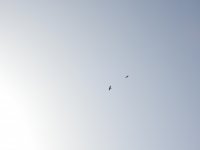A pair of Goshawks have managed to raise 2 young at an undisclosed location. They weren't discovered until fledging. They nested in deciduous trees as opposed to conifers. The female is a large bird. The pair was never spotted displaying together but separately unless they moved location. There seems to be changes locally. Certain species seem less obvious over the last few years, since the birds started showing. Green Woodpeckers seem to have vanished. Sparrowhawks are around but less showy - in fact a Goshawk was seen chasing a Sparrowhawk around. 3-5 Kestrel families would be evident around but so far 1 family with maybe 2 young was seen and that briefly. A few Kestrels are around but the late summer family parties are sadly missing. Mistle Thrushes seem invisible and at this time of year I would expect to have seen flocks numbering 6-20. Great Spotted Woodpeckers seem quiet and numbers seem very low too. Everyday a pair of recently fledged Black Headed Gull wings were found around a local reservoir - the body missing. A Barn Owl carcass was found near the nest. Magpie and Jay numbers seem less too. Ravens have nested about a mile away from the Goshawk site for a couple of decades and there families very vocal and active post-fledging. They have fledged young but the a family were seen very earl y on in Spring but not after. They seem subdued and stopped crossing over the trees where the Goshawk nested pretty early on in the season. I fact I remember them cronking in an anxious way over that spot i n very early Spring once.
There are lots of Carrion Crows and Woodpigeons still around - they don't seem impacted ..yet! A pair of Buzzards that nested in the wood has moved.
Do people have breeding Goshawks on their patch or nearby and if so do they notice changes?
There are lots of Carrion Crows and Woodpigeons still around - they don't seem impacted ..yet! A pair of Buzzards that nested in the wood has moved.
Do people have breeding Goshawks on their patch or nearby and if so do they notice changes?
Attachments
Last edited:







